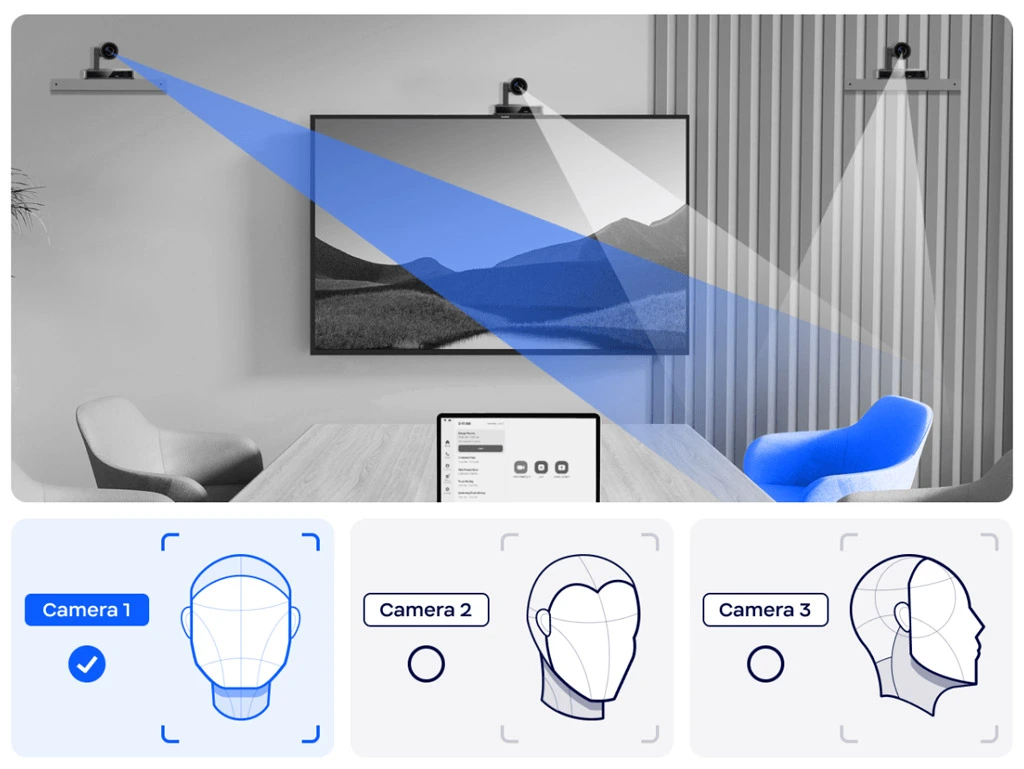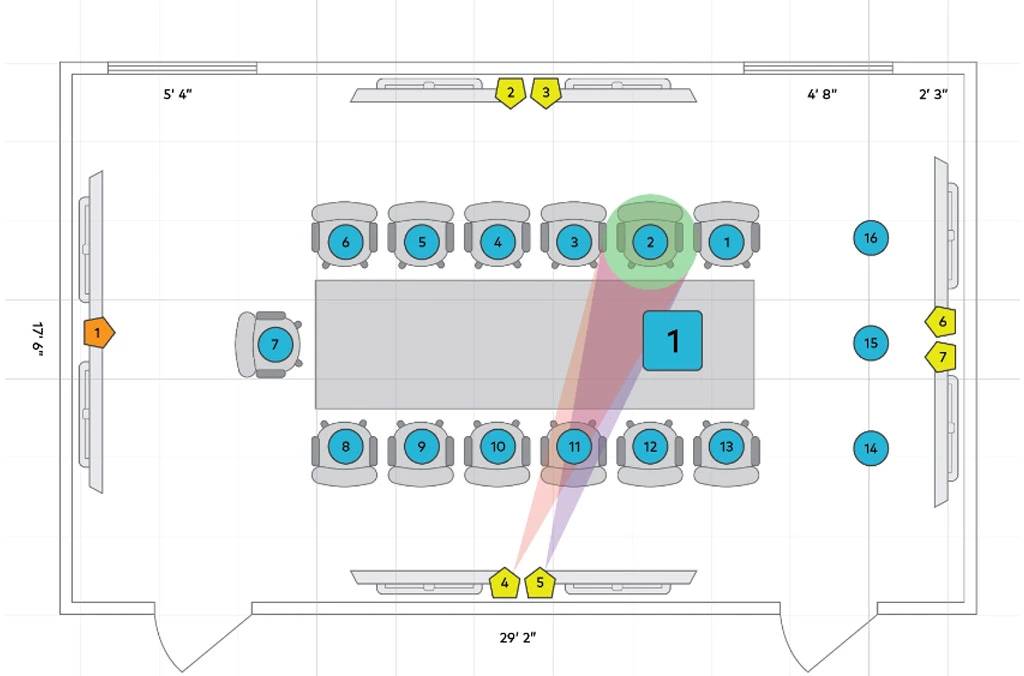Multi-camera video conferencing is revolutionising participant framing and elevating the hybrid meeting room experience, bringing new dimensions to virtual interactions
Hybrid collaboration spaces are equipped with the technology to facilitate meetings between in-person and remote attendees. This includes high-quality video and audio conferencing equipment, as well as screens and other tools for sharing content.
Even as businesses return to the office (post-pandemic), hybrid meetings remain popular, offering several advantages, including flexibility, reduced costs and increased productivity.
A key factor in hybrid meetings is participant equity. This requires each person in the meeting (present in-person or virtually) to be given equal space within the frame of the video call. This works well for in-room participants only if the camera can capture the right image and angle for each individual seated within the physical conference space.
However, organisations conducting hybrid meetings often run into a common problem. Depending on how the space is set up and the number of people in the room, getting everyone in the visible frame with clarity can be challenging.
What causes this? Single-camera setups are good at providing a sense of the whole room from a certain perspective but could be better at providing face-on visibility. This will enable an organisation to improve the VC experience and equity that hybrid meetings are expected to achieve.
While intelligent framing technology (more on this later) certainly improves the visibility in single-camera video conferencing (VC) setups, it requires multiple cameras to truly unlock its capabilities for an enhanced experience.
In the next few sections, we’ll touch on what the combination of multi-camera and intelligent framing brings to the table and how it can be implemented.
As the emphasis on better visibility of participants has evolved, organisations and room designers have started looking at multi-camera setups more closely.
The Multi-Camera Advantage for VC
In previous implementations, two camera setups served to improve visibility during VC calls, as they provided remote participants with wider viewing angles of people seated in the room. However, this became effective only after early versions of speaker tracking technology came into VC rooms, allowing participants to be kept in the frame even when they moved.

An example of multi-camera framing in action | Source: Zoom
With the advent of intelligent framing, however, the usability of the technology immediately improved by a considerable amount. While this technology improves visibility even with single-camera VC systems (which have been the norm), it’s even more effective when multiple cameras are employed
The Multi-Camera Advantage for VC
Setups with two and even three cameras are much more effective in generating a better and more realistic “front-facing” view of each participant, as they provide better viewing angles to choose from. This is especially important when there are more participants in a larger room.
As a result, organisations can now consider equipping their larger meeting or VC rooms with multiple cameras (even beyond two) as a way to dramatically improve visibility and meeting equity. This achieves far better results when combined with intelligent framing technology, and can help frame people correctly in hybrid meeting rooms.
AI also comes into play to track the movement of people in the room and to automatically pick the best camera view, ensuring that all participants are visible with excellent clarity at all times.
In our experience, we’ve found that multi-camera systems provide the best results for medium-to-large-sized hybrid meeting rooms seating up to 30 people. In addition to being more flexible and reliable, they provide the best experience to video conferencing users on both sides of the screen
Intelligent Framing In Practice
While multi-camera setups bring much-improved capability and flexibility to video collaboration systems, intelligent framing powered by AI, plays an important role.

Lorem ipsum dolor sit amet
While multi-camera setups bring much-improved capability and flexibility to video collaboration systems, intelligent framing powered by AI, plays an important role.
AI algorithms utilise computer vision and machine learning to analyse the video feed from the camera and identify people in the room. Then the AI algorithms track their movements and adjust the camera view in real time for smooth visibility for the far-side audience.
Intelligent framing can help to reduce distractions by automatically tracking the speaker and zooming in on their face. This helps to keep all participants focused on the meeting. This helps improve collaboration by making it easier for participants to see and interact with each other.
It also reduces fatigue by curbing the need for participants to constantly adjust their position to be seen. It can subsequently help to increase engagement by making it easier for participants to see and be seen.
Intelligent framing works more effectively by following the participants through three broad approaches:
Auto-Tracking Cameras: Many hybrid meeting rooms are equipped with AI-powered cameras that use facial recognition and motion tracking algorithms. These cameras can identify speakers and automatically adjust their focus and zoom to ensure the active speaker remains in the frame. This technology reduces the need for manual camera operation and ensures that remote participants can see and engage with the speaker
Voice Activity Detection: Intelligent framing can also be achieved through voice activity detection (VAD) technology. By analysing audio signals, VAD systems can determine who is speaking at any given moment. The camera can then pan, tilt, and zoom to focus on the speaker, providing remote participants with a dynamic and engaging experience. VAD is especially useful in larger meeting rooms with multiple participants.
AI-Enhanced Content Detection: In addition to tracking speakers, some hybrid meeting rooms leverage AI to detect and display content, such as whiteboards or presentation slides, on screen. AI algorithms can identify when content is being presented and adjust the camera framing to capture it. This ensures that both in-room and remote participants have a clear view of the shared content, enhancing collaboration and communication.
Next, we outline some factors organisations need to assess before setting up their hybrid meeting rooms for the best results.
Turbocharging Hybrid Meetings for your Organisation
Auto-Tracking Cameras: Many hybrid meeting rooms are equipped with AI-powered cameras that use facial recognition and motion tracking algorithms. These cameras can identify speakers and automatically adjust their focus and zoom to ensure the active speaker remains in the frame. This technology reduces the need for manual camera operation and ensures that remote participants can see and engage with the speaker
Voice Activity Detection: Intelligent framing can also be achieved through voice activity detection (VAD) technology. By analysing audio signals, VAD systems can determine who is speaking at any given moment. The camera can then pan, tilt, and zoom to focus on the speaker, providing remote participants with a dynamic and engaging experience. VAD is especially useful in larger meeting rooms with multiple participants.
AI-Enhanced Content Detection: In addition to tracking speakers, some hybrid meeting rooms leverage AI to detect and display content, such as whiteboards or presentation slides, on screen. AI algorithms can identify when content is being presented and adjust the camera framing to capture it. This ensures that both in-room and remote participants have a clear view of the shared content, enhancing collaboration and communication.
Next, we outline some factors organisations need to assess before setting up their hybrid meeting rooms for the best results.
Multi-camera systems help achieve the pinnacle of intelligent framing experiences for organisations. These systems excel in capturing dynamic and immersive content during hybrid meetings.
The number of cameras and their placement can be changed according to the room application and capacity. Depending on their size and layout, rooms can have anywhere from 2 to as many as 12 cameras to ensure that there is adequate coverage of all participants at all times. This may be especially beneficial in multi-purpose rooms and town hall spaces where greater flexibility and freedom of movement are needed.

Lorem ipsum dolor sit amet
A 7-camera setup helps cover each person and every part of the room comprehensively | (Image Source: Crestron)
By seamlessly switching between a larger number of cameras, the VC system using intelligent framing tech provides a comprehensive view of in-room participants, shared content, and surroundings. This dynamic perspective enhances engagement and communication, making remote participants feel as if they’re physically present in the same room.
Intelligent framing is an essential element in making multi-camera systems work seamlessly in Hybrid VC systems. Its combination of visual and audio-centric AI algorithms ensures constant all-participant visibility by tracking their movements and speech and adjusting camera angles. This in turn enhances inclusivity, engagement, and meeting quality.
For organisations looking to create high-level hybrid meeting environments, a good place to start is by assessing specific needs and requirements such as how many meeting rooms you have, how many people typically participate in your meetings and how much you’re willing to spend.
There are a variety of multi-camera configurations that may work for your room, so it is important to evaluate them carefully and choose the right one for your needs.
It is a good idea to pilot the configuration you prefer in a few select rooms. This will give you a chance to test their impact during hybrid meetings and consider feedback from your employees.
Adopting a Multi-camera VC System for Your Organisation
Elevating the video conferencing experience to a new level is at the core of the hybrid meeting concept. In an age where remote work and collaboration are increasingly prevalent, it’s essential to create a seamless and engaging environment for virtual participants. Multi-camera video conferencing (VC) systems, in combination with intelligent framing, represent a significant leap forward in this endeavour.
Multi-camera VC systems go beyond the limitations of a single static camera, enabling a dynamic and immersive meeting experience. These systems switch between various cameras strategically positioned in the room, capturing different perspectives, participants and shared content. This enhances the viewer’s sense of presence and engagement, making remote attendees feel more connected to the meeting.
Investing in multi-camera systems is an investment in superior collaboration, professionalism and efficiency. With precise tracking, content-focused framing and a more engaging meeting experience, organisations can foster better teamwork, decision-making and knowledge sharing. This ultimately helps them reap long-term benefits in the modern era of remote and hybrid work.
Ready to transform your hybrid meeting rooms with state-of-the-art camera systems? Partner with Actis Technologies, one of India’s leading system integrators with a legacy of over 5 decades in the AV space. Get in touch with Actis Technologies at 022-30808000


